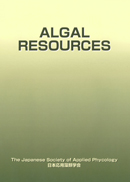Volume 13, Issue 2
Displaying 1-26 of 26 articles from this issue
- |<
- <
- 1
- >
- >|
Mini review
-
Article type: Mini review
2020 Volume 13 Issue 2 Pages 27-31
Published: 2020
Released on J-STAGE: August 18, 2021
Download PDF (2845K) -
Article type: Mini review
2020 Volume 13 Issue 2 Pages 33-39
Published: 2020
Released on J-STAGE: August 18, 2021
Download PDF (1898K) -
Article type: Mini review
2020 Volume 13 Issue 2 Pages 41-46
Published: 2020
Released on J-STAGE: August 18, 2021
Download PDF (1901K) -
Article type: Mini review
2020 Volume 13 Issue 2 Pages 47-53
Published: 2020
Released on J-STAGE: August 18, 2021
Download PDF (5608K) -
Article type: Mini review
2020 Volume 13 Issue 2 Pages 55-59
Published: 2020
Released on J-STAGE: August 18, 2021
Download PDF (1710K) -
Article type: Mini review
2020 Volume 13 Issue 2 Pages 61-67
Published: 2020
Released on J-STAGE: August 18, 2021
Download PDF (1881K) -
Article type: Mini review
2020 Volume 13 Issue 2 Pages 69-76
Published: 2020
Released on J-STAGE: August 18, 2021
Download PDF (2718K) -
Article type: Mini review
2020 Volume 13 Issue 2 Pages 77-84
Published: 2020
Released on J-STAGE: August 18, 2021
Download PDF (1999K)
Addendum
-
Article type: Addendum
2020 Volume 13 Issue 2 Pages 85-89
Published: 2020
Released on J-STAGE: August 18, 2021
Download PDF (1320K) -
Article type: Addendum
2020 Volume 13 Issue 2 Pages 91-93
Published: 2020
Released on J-STAGE: August 18, 2021
Download PDF (1236K) -
Article type: Addendum
2020 Volume 13 Issue 2 Pages 95-101
Published: 2020
Released on J-STAGE: August 18, 2021
Download PDF (5096K) -
Article type: Addendum
2020 Volume 13 Issue 2 Pages 103-106
Published: 2020
Released on J-STAGE: August 18, 2021
Download PDF (1240K) -
Article type: Addendum
2020 Volume 13 Issue 2 Pages 107-110
Published: 2020
Released on J-STAGE: August 18, 2021
Download PDF (1438K) -
Article type: Addendum
2020 Volume 13 Issue 2 Pages 111-115
Published: 2020
Released on J-STAGE: August 18, 2021
Download PDF (1957K) -
Article type: Addendum
2020 Volume 13 Issue 2 Pages 117-122
Published: 2020
Released on J-STAGE: August 18, 2021
Download PDF (1761K)
-
2020 Volume 13 Issue 2 Pages 123-126
Published: 2020
Released on J-STAGE: August 18, 2021
Download PDF (1038K) -
2020 Volume 13 Issue 2 Pages 127-131
Published: 2020
Released on J-STAGE: August 18, 2021
Download PDF (4038K) -
2020 Volume 13 Issue 2 Pages 133-137
Published: 2020
Released on J-STAGE: August 18, 2021
Download PDF (5681K) -
2020 Volume 13 Issue 2 Pages 139-143
Published: 2020
Released on J-STAGE: August 18, 2021
Download PDF (1064K) -
2020 Volume 13 Issue 2 Pages 145-149
Published: 2020
Released on J-STAGE: August 18, 2021
Download PDF (1062K)
Original articles
-
2020 Volume 13 Issue 2 Pages 151-162
Published: 2020
Released on J-STAGE: January 03, 2022
Download PDF (3629K) -
2020 Volume 13 Issue 2 Pages 163-169
Published: 2020
Released on J-STAGE: January 03, 2022
Download PDF (7754K) -
2020 Volume 13 Issue 2 Pages 171-180
Published: 2020
Released on J-STAGE: January 03, 2022
Download PDF (4468K) -
2020 Volume 13 Issue 2 Pages 181-186
Published: 2020
Released on J-STAGE: January 03, 2022
Download PDF (2096K)
-
2020 Volume 13 Issue 2 Pages 187-193
Published: 2020
Released on J-STAGE: January 03, 2022
Download PDF (2556K)
-
2020 Volume 13 Issue 2 Pages 195-
Published: 2020
Released on J-STAGE: January 03, 2022
Download PDF (2599K)
- |<
- <
- 1
- >
- >|
